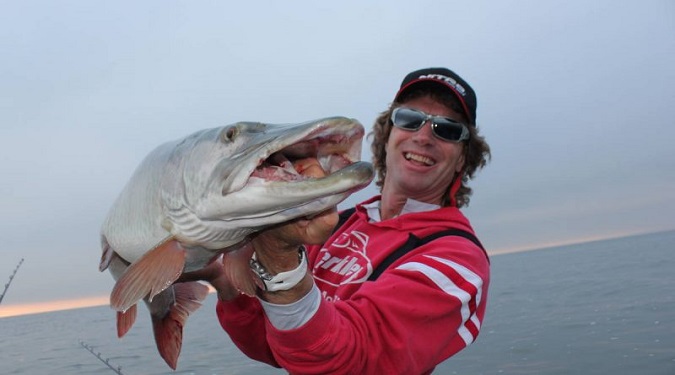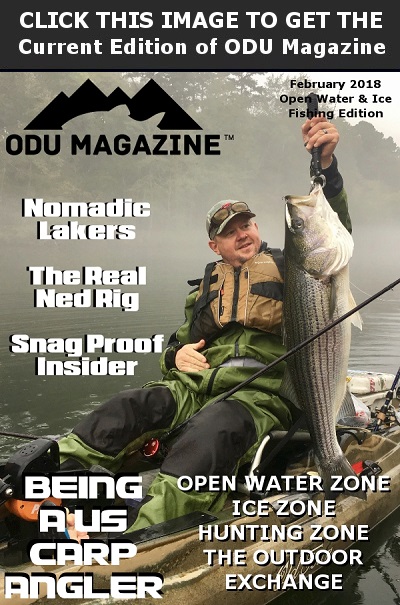After an especially long winter like the one we just experienced, it feels especially great when it gets to be the opening of the muskie fishing season. Time to fish for big toothy critters in open water – Let the madness begin! This early season period is really relative with respect to latitude, but in the more traditional muskie range of the northern U.S. in the Midwest – to east – and to Canada directly north about midway up in the provinces of Ontario and Quebec, this means anywhere from late May to late June. Where these traditional fisheries have always relied (and most still do) on natural reproduction to keep the fisheries going – muskies are protected from intentional angling pressure until after it’s known the fish have finished spawning – before the season opens. This (spawning) generally occurs when surface water temperatures reach the mid-to-upper 50’s, which relates to seasons opening from the end of May (in Wisconsin) to the third Saturday of June in Canada.

Muskies spawn in soft-bottom vegetated (where weeds are starting) areas. These are fairly easy to find on most waters. They are generally bays; any creek/river inlets are a definite prime zone. While more fertile waters may have lots of area suitable for spawning, some waters have very limited spawning areas; generally these are your deeper, clearer waters. Contrary to some popular advice – such waters can actually be the best targets for the “open” and early part of muskie season in many places.
These zones where muskies spawn then – and areas and structures adjacent – are the prime targets for early season fishing. In areas with open season prior-to and during spawn (generally only waters [hopefully] where muskies are incapable of natural reproduction) – right in the spawning areas themselves and just-adjacent make the most sense to concentrate the majority of efforts until spawning is over. That’s the one thing that all muskies have to do – or at least try to do. The rest of the season they go wherever they like. Evidence strongly suggests that muskies move on to their preferable locations (food & comfort) fairly quickly after spawning. There is no long “recoup” period where they remain in spawning areas, though some of the fish may choose to stay there for a long period of time.
In the case of traditional muskie zones, with seasons opening post-spawn, targeting lakes that offer limited spawning zones – right at the open – is likely to also offer a situation where fish are still concentrated. Some fairly large waters may have only one or two prime spawning bays, so all muskies will end up there for that short period of time that they are spawning. While they will move and spread out from there – it is a gradual process, so the spawning area itself, adjacent structure, open water and all breaklines moving away from spawning zones are higher percentage spots.
 It is often suggested that searching for lakes that warm quickly (i.e. shallower more stained waters) and offer early weed growth are the best lakes to target – also that searching for the warmer waters on those lakes often means more active fish. These are good general rules too and certainly not bad advice, but these are generally the waters that also have spawning habitat spread throughout the lake – and therefore fish are more spread out. Looking for warmer water is a good plan, but the daily weather patterns themselves consistently have more to do with fish activity (“catching” potential) than do the warmest surface temperature readings in the area. Certainly don’t avoid clearer waters that warm slower for that reason only.
It is often suggested that searching for lakes that warm quickly (i.e. shallower more stained waters) and offer early weed growth are the best lakes to target – also that searching for the warmer waters on those lakes often means more active fish. These are good general rules too and certainly not bad advice, but these are generally the waters that also have spawning habitat spread throughout the lake – and therefore fish are more spread out. Looking for warmer water is a good plan, but the daily weather patterns themselves consistently have more to do with fish activity (“catching” potential) than do the warmest surface temperature readings in the area. Certainly don’t avoid clearer waters that warm slower for that reason only.
Regardless of lake choice, check those areas. Try very shallow in spawning areas and any new weed growth in and adjacent to them. Try any wood or rock cover as well. Probably the most underrated spring locational pattern is open water fishing – in all types of waters, but often, especially-so in those clearer waters with little weed growth. And, if only one or two spawning areas exist in the lake – that deep water adjacent to spawning zones offers great odds. Understand that muskie do prefer the warmer water in the area in spring for comfort. And the vast majority of the forage does too. In spring, what part of the water column is the warmest? Most fish and predators will be in that upper layer, during the day, especially on warming sunny days.
As with any time of year, it should be a patterning process. In clear water, sight fishing offers potential in the shallows, too. But try the obvious structures and edges; if fish are found look for more of the same. At this time though, I often try open water fish first – as the best place to attempt to pattern active muskies. And I don’t need to bother running lures any deeper than the visibility of the water to catch fish. Open water fishing is very hard for most to get confidence in. There’s something about fishing in deep water, with no visible structure at all – that just kills many angler’s psyche. In reality, it’s really a pretty small zone though, especially in spring, when concentrating on the top layer (basically the upper 15 feet) – and the deep water adjacent to spawning zones. Always drop a waypoint or some type of marker when a fish is contacted in open water, as predators do bunch up.
When it comes to presentations, a good general rule is that smaller lures will overall be more effective. In cooler water slower presentations are generally better; lots of pauses with erratic lures … those neutrally-buoyant can be especially effective. As waters warm, the larger stuff should work better. Gradual warming days are generally best; cold front days or hot (fast-warming) are abnormal and will generally require more in-their-face presentations and less action/speed. There are no rules though; only
probabilities. Don’t leave the big baits home and certainly don’t leave the surface baits home (in case you’ve heard the theories about waiting for baby ducks to appear before trying).
Crank and jerk baits are likely my overall favorites in spring. Imitating wounded critters with lots of pausing can be very effective. The Sebile Magic Swimmer (that straight snake-swim is very enticing presentation too). Soft plastics can be a great option too!
For some reason, spoons can be especially effective for the open water situations. Not that deeper diving lures won’t work, but again, overall, run lures shallow in the water column. Topwater should not be considered out of the question whether it be a foot of water or sixty. If fish are located on a specific spot, but not triggered, one of the best choices to come back at ‘em with later is a topwater.
Again, I understand that fishing open water is an intimidating concept to many, but think of it like this: The muskies have been up in shallow water spawning in warm water. Now they are done, and ready to eat. They still want to be in warmer water, as do their prey – and the upper 10 to 15 feet of the water column offers that preferred temp range. So the muskies simply cruise out of their spawning areas toward open water, but staying at the same basic depth level they were in when in shallow water. It’s a horizontal move to deeper water, not a vertical move to deeper water. Understand this and you’ll be fishing the right zone to get your Next Bite!

